
Mediterranean Garden Society

Mediterranean Garden Society
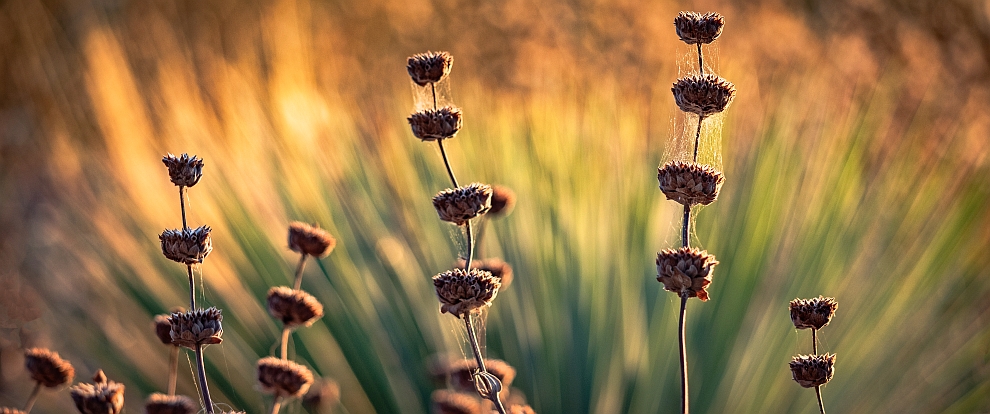
Adding to an Existing Olive Grove on Skopelos
by Janet Ibbotson
Photographs by Martin Beckett
Photographs to illustrate the article published in The Mediterranean Garden No. 122, October 2025
The photo at the top of this page shows September colour and texture in the garden - seedheads of Salvia clevelandii ‘Allen Chickering’ and Yucca rostrata (Photo Martin Beckett)
Janet writes: Creating combined Greek island living spaces/gardens in a steep, rocky, sloping olive grove, just above the sea and with a westerly aspect, was guaranteed to present challenges and an equally steep learning curve.
As the single entrance to the olive-terraced site snakes its way down the hillside, the bulldozer, Bobcat, builders and gardener all had to work backwards across the plot, constructing first the pool, the lower garden (now just over two years old) and main house, then the studio and finally the courtyard and gravel garden (one year later).
Even though the garden was made in two parts, its design was integral to the overall plan for the construction. The position of buildings on either side of the courtyard was determined by a space between existing olive trees. The front of the main house and the studio centred on a point midway between olive trees, ensuring privacy for the master bedroom and a view to the Skiathos lighthouse from both bedrooms.
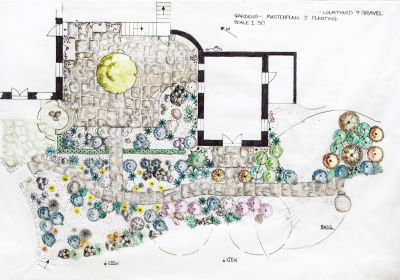
The courtyard’s main purpose is to unify the buildings but it also provides a space for outdoor living and sheltered seating in winter.

As one looks from the courtyard and across the gravel garden to the sea, low to mid-level planting frames the view without obstructing it, a fourth ‘wall’ being a low hedge of Pistacia lentiscus which is only now emerging from the other planting.
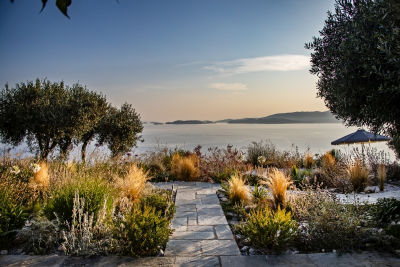
A path, planting beds and patios flow around and under old olive trees, circling the small swimming pool before rejoining the main pathway connecting back to the gravel garden, courtyard and buildings.
At the south end of the garden, at what is now its lower entrance, a single mature Pinus halepensis (Aleppo pine) marks the end of the garden. To the north, two overlapping crinkle-crankle (convex and concave) walls provide shelter for the pool area and behind these walls more olive trees mixed with native trees and bushes are used as a shelter belt, blending the garden back into the landscape.
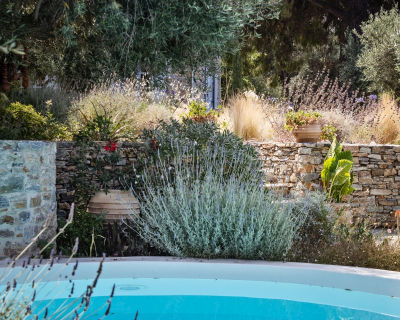
the old terracing found on the surrounding hills and adding interest to the garden. In some cases, olive tree trunks are now set deeper in the soil (no more than half a metre) but only one tree was removed and successfully replanted elsewhere on the land. Behind the studio and courtyard, two small terraces have recently been planted with citrus trees and a related Bergera koenigii (syn. Murraya koenigii) which survived the previous eight years as a pot plant and is now growing happily into a small tree.
At around 75 metres above sea level, the west-facing site is exposed to afternoon and evening sun. In the mornings it is cool and shaded until about 10.00. The garden occasionally catches the turbulent north-west wind and the drying south-west wind but is otherwise protected by native trees such as Ceratonia siliqua, Cercis siliquastrum and Olea europaea. The hillside behind us shelters the garden from the island’s dominant north-east winter wind and the northerly meltemi in summer.
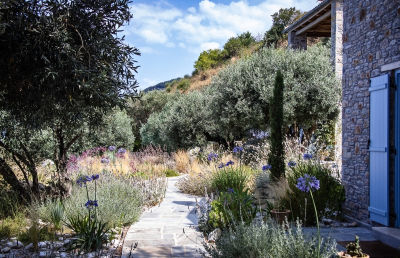
The soil is poor, free-draining, typically stony, low in organic matter and with a high mineral content. For more detailed information on the fascinating geology of Skopelos, as well as on native wildflowers, see Sue Warren’s excellent website.
Local topsoil was incorporated into the planting beds along with perlite, sand and some compost. All are essential as the garden - particularly the courtyard and its gravel garden - were at the centre of the building site and had been reduced to builders’ rubble, cement run-off and stone chips left by the masons.
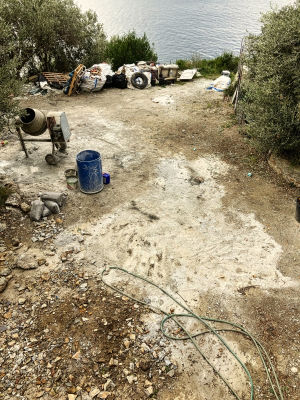
Interestingly, Mediterranean gardens now being created in the UK incorporate these same materials to reduce naturally fertile soils. However, when added to already poor Mediterranean soils they make a very poor planting medium.

With no water source and no mains water supply, both house and garden rely on a closed cistern fed from rain falling on the main roof and on water tanks fed from run-off from the driveway and studio roof. Plenty of rain falls on the island, though not between May and September. Mains water is at a premium in summer, so being self-reliant means that we make no demands on the island’s supply. Water stored in the tanks is available for the swimming pool, vegetable garden, polytunnel, fruit trees, chickens and the vineyard. Garden-wise, cistern water is used only for pots close to the house and for keeping new plantings alive during periods of summer drought. In the summer drought of 2024, the gravel garden’s first year, the garden was watered twice by hand between June and September. This year, at the end of June, some plants are showing signs of stress so spot watering may be needed in early July.
As far as possible, the principles encouraged by the Mediterranean Garden Society are followed. The garden has no irrigation system and is not watered other than during periods of severe drought. A period of summer dormancy is allowed with structural planting replacing flowers for impact. Plants are suited to the conditions; they come from mediterranean-climate regions around the world, including of course those native to the island of Skopelos and to Greece. The selection of plants encourages pollinators and the olive tree canopy and trees and shrubs at the garden’s edges are full of birds. Groundcover planting and rocks and pebbles provide wildlife with highways through the garden. Gravel is used as a thick mulch, as are olive leaves in the lower garden (though not close to plant roots).
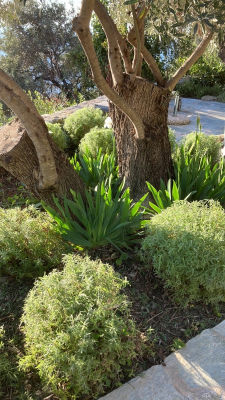
Lavandula dentata and wild Iris germanica under olive trees hard pruned by the
previous owner
but now providing umbrellas of shade in the pool garden
The olive trees were hard-pruned for wood about 10 to 15 years ago by previous owners but are now pruned into umbrella shapes to provide shade for both humans and plants. The plants need only a low level of fertility and no pesticides, herbicides or chemical fertilisers are used in the garden.
The wide choice of plants found in northern Europe’s nurseries and garden centres is not available here. Quality can be erratic, or plants are not ready for sale at planting time in winter and early spring. Once delivered to the island, plants cannot easily be rejected and returned to their mainland supplier without incurring additional cost. Delivery costs for large specimens or for small orders of specialist plants can also be prohibitive. Perennials and shrubs are rarely labelled so the gardener needs plant identification skills, as I found when ordering several types of Salvia together. Flower colours are specified but arrive in a mix and once planted and in flower it is too late to change their position. When I require special plants I order them from Gryllis Water Lilies, the nursery of an MGS member, and I have had some success germinating seed from sources such as Mediterranean Seeds and Bulbs, although keeping seedlings in pots alive until autumn planting time can be a challenge.
Lavandula dentata often arrives in mixed batches of three slightly different types - silver-leaved, grey-green-leaved, some with long thin flowers and others with shorter, fatter plumed flowers. From a distance a mixed planting makes little difference but from closer the difference is noticeable. I prefer to plant lavender under olive trees where the flowers can be enjoyed for as long as possible before the plants are cut back into ball shapes. My last cut was in the winter and the lavenders are ready for cutting again now, at the end of June. I find the lavender combines beautifully with early spring flowering Iris × germanica which does not object to olive tree roots. With white, blue and purple flowers, these grow everywhere on the island of Skopelos. This local combination of trees and plants provided me with a useful starting point for my planting design.
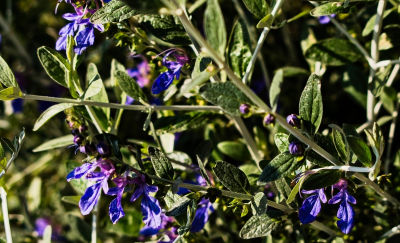
Other structural plants are Teucrium fruticans, preferably the slightly smaller and dark blue cultivar ‘Ouarzazate’, when it is available. It flowers madly from January to May but seems quicker to shut down in drought conditions. Deliveries of Rosmarinus officinalis (syn. Salvia rosmarinus) ‘Prostrate Group’ included two different unnamed types, one an excellent groundcover though still a bit spindly after two years, the other more arching with longer leaves. In summer, however, they are festooned with cobwebs, so not ideal next to the pool or seating. For some reason, Westringia fruticosa is less successful and suffers dreadfully in drought conditions. In the gravel garden, the rounded shape and fresh evergreen leaves of Cneorum tricoccon are pleasing, as are its tiny yellow flowers in spring and red button fruits in summer, but it is slow-growing and is unlikely to reach much more than a metre in height. In the courtyard I have used Polygala myrtifolia ‘Nana’.
Although it may be a common garden plant, this shrub has a pleasing shape, is evergreen with lovely purple pea-type flowers for most of the year and repeat flowers every time it rains. I also use succulents for structure including Yucca rostrata and Y. gloriosa which hold their rounded outline without any attention from me. Agave attenuata is another favourite, partly because it has proved easy to propagate but also because of its lovely glaucous foliage. In more shaded areas I use Pittosporum tobira ‘Nanum’ and, screening either side of the studio doorway, I have used Dodonaea viscosa with its purple and lime green fluttering leaves.
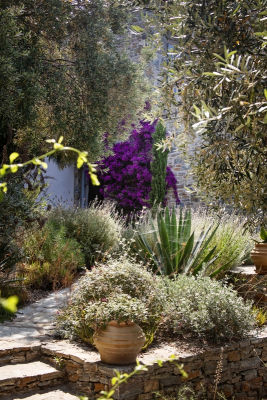
In the lower garden a pot of Pelargonium sidoides, a ball of Teucrium fruticans,
Convolvolus cneorum and cobwebbed Yucca gloriosa. Bougainvillea glabra cloaks the house wall
Convolvulus cneorum either loves the conditions or dies out immediately; it sometimes forms mounds and at other times develops a trailing habit. Other stalwarts are white Oenothera lindheimerii (previously Gaura), Erigeron karvinskianus and white and blue Agapanthus africanus.
In shaded beds on either side of a stepping-stone path leading to the bedroom are Bulbine frutescens ‘Hallmark’ and Achillea millefolium ‘Moonshine’. The achillea was disappointing in its first year but its creamy-yellow flowers are performing brilliantly this year. There is also Santolina rosmarinifolia and S. chamaecyparissus and more erigeron.
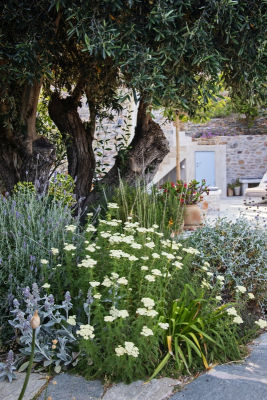
Achillea millefolium ‘Moonshine’, with upright stems of Festuca mairei,
LHS Stachys byzantina, lavender and euphorbia, RHS a ball of Teucrium fruticans ‘Ouzazarte’
In the gravel garden Salvia clevelandii ‘Allen Chickering’ is a delight, though at the end of June only its purple-brown seedheads are left standing. Salvia ‘Bees Bliss’ has been disappointing, trailing sadly along the ground. A single Salvia canariensis is fabulous and won’t be alone for long as itis happily self-sowing. Close by is the Skopelos native Salvia pomifera. Bees and other pollinators adore Nepeta racemosa subsp. racemosa (syn. N. mussinii), blue-flowered Salvia officinalis and Stachys byzantina. All are excellent though the last virtually disappears under a mat of wilted foliage in late autumn and is not seen again until the following spring. In the gravel garden a colour combination appearing only in early spring is splashes of red Papaver rhoeas and theyellow and white of Leucanthemum vulgare and chamomile. All burn off by the end of April and once they have set seed the gravel is cleaned.
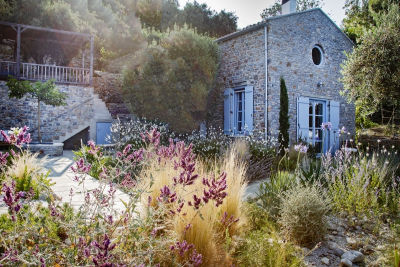
Looking into the courtyard to the guest house - Salvia canariensis, Nasella tenuissima,
Pseudodictamnus mediterraneus and Salvia yangii ‘Blue Spire’
Grasses include the ubiquitous Nassella tenuissima (formerly Stipa tenuissima), attractive in every kind of light but fabulous with the sea behind it. Hyparrhenia hirta spreads happily along the roadsides here, but I have had limited success transplanting it to the garden. I would like more of the beautiful firework plumes of Festuca maireii but this plant from the Atlas Mountains is difficult to obtain. I also have Cenchrus longisetus (syn. Pennisetum villosum). Originally planted next to a path, it became a thug and the plants were removed after a seedhead got stuck inside my dog’s ear; it also proved to be strongly allergenic. Since I was unwilling to remove all of these beautiful grasses from the garden, a few are now permitted at the very front of the gravel garden, well away from the dog’s ear and my nose and where they can out-compete the weeds.
Local plants Ptilostomen chamaepeuce, Euphorbia characias subsp. wulfenii and Pseudnus mediterraneus (formerly Ballota pseudodictamnus) self-sow around the garden, as do Perovskia atriplicifolia (now Salvia yangii) ‘Blue Spire’,and Marrubium, probably M. vulgare, which after a year has still to demonstrate its worth. Seedlings are moved to where they are of most use. Nassella is a self-sowing nuisance but its small tufts are tolerated as they are easily removed after rain.
I would not change the layout of the garden but if I were to plant again I would limit myself to fewer types of plants and would plant in bigger swathes with less dot planting - both temptations for every self-taught designer. I would also use more dark green evergreen structure, perhaps Myrtus communis subsp. communis (syn. M. communis var. microphylla) .I would add lots more Festuca maireii in the gravel garden and forget the pesky Cenchrus longisetus (Pennisetum villosum). There would be much more Pseudodictamnus and no Marrubium, more Nepeta and Salvia ‘Allen Chickering’ but no ‘Bees Bliss’. I would also remember to plant Salvia yangii ‘Blue Spire’ (Perovskia) closer together and in quantity but definitely no Oenothera speciosa ‘Pink Ladies’with its disproportionately large, luminous pink flowers, which are astonishing for a month but out of place in my garden. Its stringy stems have to be cut to ground level in summer, leaving gaps in the planting while its roots invade other plants underground.

Salvia clevelandii ‘Allen Chickering’ in full flower with Nasella tenuissima,
Pseudodictamnus mediterraneus, dried flower heads of Euphorbia wulfenii
We are now finishing the driveway and parking area above and have planted a hedge of pomegranate (Punica granatum) which is doing well and has multiseasonal impact. There is also new planting to tend on either side of steps leading to the kitchen where I am trying Phlomis fruticosa with mounds ofmastic (Pistacia lentiscus) and small-leaved myrtle bushes,more prostrate rosemary andseedling euphorbias. This year we added the polytunnel to extend the growing season and for seedlings. The vegetable plot is expanding and our thoughts are now turning to fruit trees. How this part of the plan develops is dependent partly on how successful we are at improving and balancing fertility but probably most important is how well the plans for drought-proofing progress. It was never going to be an easy site to tackle but despite some cruel summers we are reasonably happy with the results so far ...
THE MEDITERRANEAN GARDEN is the registered trademark of The Mediterranean Garden Society in the European Union, Australia, and the United States of America
website designed and maintained
by Hereford Web Design